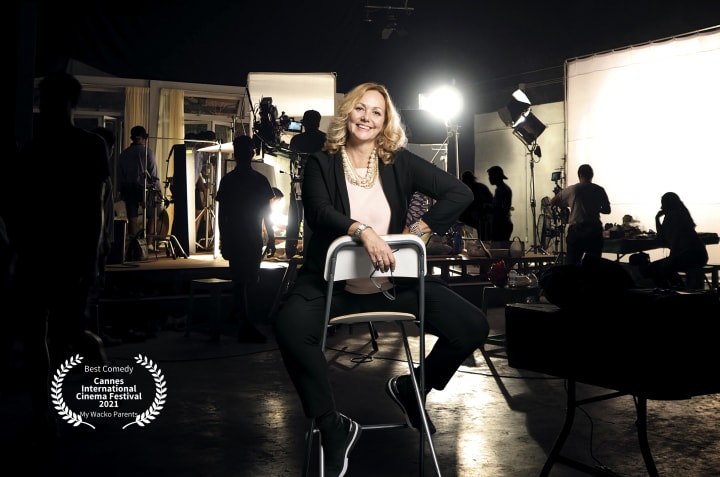An Interview with Tina Adams.
Tina Adams is an award-winning filmmaker and producer. Her latest documentary Concealed Identity is about an unbelievable story of survival, identity, and mystery. Watch the trailer below.
- Tina Adams is an award-winning filmmaker and producer currently living in Canada. Over the years, she has written and produced many films, including The Perfect Kiss, Hotel Limbo, My Wacko Parents, and documentaries like Harlem and Concealed Identity.

We sat down with Tina and asked her some questions about filmmaking and the life and times of being on set. Here is a selection of some questions and her answers.
Movies: Is a film shot in an order that coincides with its plot?
It would be a dream to film everything in the same order as it is written. But because in a movie, we return multiple times to the same location, those scenes are usually put together on a schedule and filmed all at once. This means that a film is not shot in the same order as they are sequenced on screen. Logistically, it would be crazy to shoot a scene in one location, then go to the next, and return to the same previous location to shoot another scene. It's like moving your entire apartment every time you go somewhere. If you try to do that to maintain continuity in your life, it would be impossible to do anything.

What is the difference between act, scene, and episode in script writing?
These terms are some of the very oldest established during the earliest recorded theater experience of ancient Greece.

They wrote theatrical performances made to be watched and performed under the open sky of an amphitheater. The Greek realized that good storytelling has three acts:
- The Opening Act
- The Second Act
- The Third Act: Resolution (Catharsis)
First, the opening, where everything is set, is when the conflict is first exposed. Then during the second stage, the characters are established and their struggle with the conflict begins. Then finally, an ultimate resolution at the end.
When an ending is tragic, the play is called a tragedy. On the other hand, when the play finishes with a happy ending it is called a comedy.
Today, this structure of storytelling still prevails. When you read a novel, or watch a film you still need to find out who the characters are and what conflict they have, and then if you are interested, only then do you decide to continue watching or reading.
As a scriptwriter, you fundamentally study this structure, and learn to adapt it to the big screen. For example, the first act needs to happen within the first 7 minutes, where the tone, mood, and characters are all introduced.
A scene is just part of the act. For example, if you look at a set of Lego, each piece is like a scene that builds a larger structure: the act. Similarly, this same structure continues to scale when creating a series.
In a series, the ending of each episode is not a full catharsis leaving room open for the next episode and continuity within a season. Similarly, each episode does not need to constantly establish characters every time because it was already done during the first 7 minutes of episode one.
So if you skip the first episode, you will miss important information because you missed act one of the entire series.

Therefore, during the days of cable TV, a broadcaster would run a recap of the previous episodes to help people that could not go back in time and watch the episode they missed. This was helpful for viewers that joined later during a season. Today, because you can go back and watch any episode from any series this practice has been abandoned.

Sometimes scriptwriters can surprise us by inventing a new story even after an established catharsis. Still, they have to introduce new characters and new conflicts to begin a new narrative. For example, we were all sure that at the end of the first season of The Walking Dead the series was totally done. Instead, the iconic Netflix series introduced a second season by creating new characters and building upon the idea that the main character had changed to become the evil devil he was once fighting during season 1. The conflict then shifted and he became the most wanted criminal in the series and it became a battle between him and his brother-in-law.
What do extra actors talk about in the background?
I love this one; it's funny! Thank you for the question.
We probably all know that the actors in the background are just moving their mouths without making any sound during the take. The main reason is to not interfere with the dialogue of the main characters being recorded. The sound needs to be clean so that the sound editors can work and edit the file. That's why they just move their mouths and pretend to speak.
Of course, that creates many funny situations on set, many of them turning into bloopers. Sometimes, the actors have various silent conversations using gestures and discreet sign language. Similarly, when they are allowed to speak, the non-scripted conversations are sometimes meaningful.

Sometimes there are also logistic reasons for silence. For example, how do you establish the difference between the extras and the actors? The unions created a simple rule, if you speak during the recording, i.e., you have a line, you would be considered a talent and not an extra. Then the producer must include your name in the credits. As a result, you are upgraded in your role and paid more. For this reason, film productions prefer silence in the case of extras because it's a headache to establish someone within a union if they are not already part of one.
Some productions avoid these situations by engaging the extras in silence while moving their mouths without speaking.
It happened to me on the set of a movie my friend Lydia Amor participated in. She was in the background and entered a scene with the leading actor where she spoke just one line. Then after the film came out, she watched the movie and heard herself speak. So she contacted her Union, Actra, and was able to go back and get a bonus for that line.
There was another story where a young woman was cast in a film. She was recorded as a young woman dropping some of her travel documents on a train. Unfortunately, the producers cut that scene out from the final film during post-production. So imagine her shock during the premiere. She was in utter tears and devastated. No amount of money can cover that feeling.
Indeed, this is the world of acting. You never know if your scene will be used or eliminated.
One of those heartbreaking tales I remember was about Quebec Actress Sophie Lorain. She had a major role in the Oscar film, The Barbarian Invasions by Denys Arcand. The film won over 50 awards, including Best Writing, Best Original Screenplay, and Best Foreign Language Film. But unfortunately, she was cut out from the international edit and was only included in the French one that aired primarily in Canada. So she did not win the Oscar, even though the international version did win those Oscar awards. So imagine her grief and turmoil; I can say it's strange and traumatizing.
It happened to me in the movie Polytechnique by Denis Villeneuve. I was still mentioned in the final credits and still receive royalties. You can check my name there, Tina Adams, I am not in the movie; my scene was cut out.
Method acting is a technique that allows you to become a character.

As an actor, you do not play yourself; so you need to use the expressive tools within you to convince the people watching you to believe that you are indeed that exact character in everyday life. For that reason, actors train to use those tools to make themselves and others deeply believe in their performance.
The most important part of method acting is changing the way you view yourself to become that character and personalize the personality you are playing. The idea is that you are doing it from deep inside your very being. Thus the method refers to this technique used to change your own very expressions in uniformity with creating the desired character.
Method acting is a very interesting system originally developed in Russia and used more than 100 years ago by actors ever since. In 1937 when Stalin began the genocide of his people, a Russian named Mikhail (Michael) Checkov escaped to the US and brought with him the methodology, which he then introduced to the American film industry.
How do filmmakers create compelling emotional scenes?
There is a short film made by Hitchcock that I like. It is a perfect example of this phenomenon. It's all about editing.

Imagine a picture of a beautiful young woman by a tree as she turns her eyes toward the camera and smiles. Then cut to an old man standing further away behind another tree gazing at her with a creepy ill-intentioned smile. You feel that something bad is about to happen to the young woman.

Now, instead:

Imagine the same scene of the young lady, but instead of a creeping old man, you have an older gentleman, well dressed, walking towards her with loving eyes, ice cream in his hands, and a sun umbrella coming to join her because he is her grandfather.
The first scene of the young lady is exactly the same, but the reactions are completely different.

Eisenstein first explored this sequencing phenomenon to create different emotions in the viewer 120 years ago during the era of black and white film. It was based on Pavlov's experiment in psychology that showed how learning and conditioning worked. Since then, filmmakers slowly began implementing this to create specific emotional responses. Before Eisenstein employed this tool, he made trailed and tested different sequences to find out how it worked. He realized it all depended on the scene you put after that first scene and how you built the series of images.
It's pure psychology.
***
We hope you enjoyed our latest interview with Tina Adams and are thrilled to being more knowledge, stories and wisdom from the filmmaking world. Join us as we explore more questions and tell more stories about film, script, editing and everything related.
Until next time, cheers!

About the Creator
7 Art Distribution
Over 20 years, Seven Art Distribution has supported Independent Filmmakers by providing them a channel to bring their art to screens all around the World.
Enjoyed the story? Support the Creator.
Subscribe for free to receive all their stories in your feed. You could also pledge your support or give them a one-off tip, letting them know you appreciate their work.






Comments
There are no comments for this story
Be the first to respond and start the conversation.